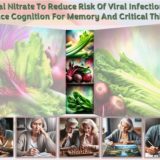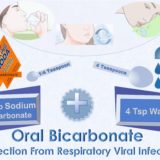Oral Nitrate to Reduce Risk of Viral Infection and Enhance Cognition for Memory and Critical Thinking

Oral nitrates are substances which appear in our food. They occur naturally in leafy green vegetables like raw spinach, beets, celery and lettuce. Fruits and vegetables containing nitrates provide protection to health.
Nitrates are also added to some foods like processed meat products. They add color and taste as well as preserve against spoilage. If large amounts are added they make chemicals which could increase risk of cancer.
We do know that nitrates have never actually caused cancer. But how much can be added to processed food is limited by law. When obtained through fruits and vegetables, nitrates have good effects on health.
Nitrates are produced in almost all our cells as well as absorbed from food. As a result, more than 90% of nitrates in blood and tissue are formed in our bodies.
Enzymes combine organic molecules with oxygen to create nitric oxide. This formation occurs in all tissues, including skeletal muscle and brain.
Nitric oxide is a small but highly reactive molecule. It lasts only a few seconds before it reacts with other molecules. It diffuses rapidly across cell membranes influencing other cells in all directions.
The reactions influence many functions. They control:
• blood flow,
• nerve function,
• metabolism,
• muscle contraction,
• immune response, and
• inflammation.
Any nitric oxide that’s not immediately combined with other molecules transforms into nitrite. That form lasts several minutes before turning into nitrate. Both nitrite and nitrate can immediately be reduced back to nitric oxide. Which makes nitrate into a local storage source. That action makes nitric oxide available when local production is not enough.
Skeletal muscle produces nitrate and stores it during rest. During exercise, nitrate gets reduced to nitric oxide. The newly formed nitric oxide increases blood flow, energy production and force of muscle contraction. During rest, nitrate is reformed and acts as a reservoir for rapid formation of nitric oxide whenever it’s needed.
Concentration of nitrate in skeletal muscle is much greater than in blood plasma. As a result, nitrate transfers into blood and circulates throughout the body. That provides a source of nitric oxide wherever it’s needed anywhere in the body.
Brain uses the most energy for its size of all organs and tissue. The human brain weighs about 2% of total body weight but takes about 20% of all the energy being used at rest. Some of the energy is used to maintain cell structure and function. Most is used to generate electrical signals that pass through connections between cells.
Nitric oxide is a signaling molecule between cells. It activates and controls cognitive functions. Those include learning and memory mechanisms. Nitric oxide also helps regulate cerebral blood flow. In that way, it supplies oxygen and nutrients for energy.
Circulation and Storage of Nitrates
During normal function, cells produce more than enough nitric oxide. Extra nitric oxide quickly forms nitrite and nitrate. Some remains locally as a reservoir. Whenever suddenly needed, nitrate is reduced to nitrite which is reduced to nitric oxide. The rest can circulate away from where they were formed. In this way, nitrate serves as a transport and storage form of nitric oxide.
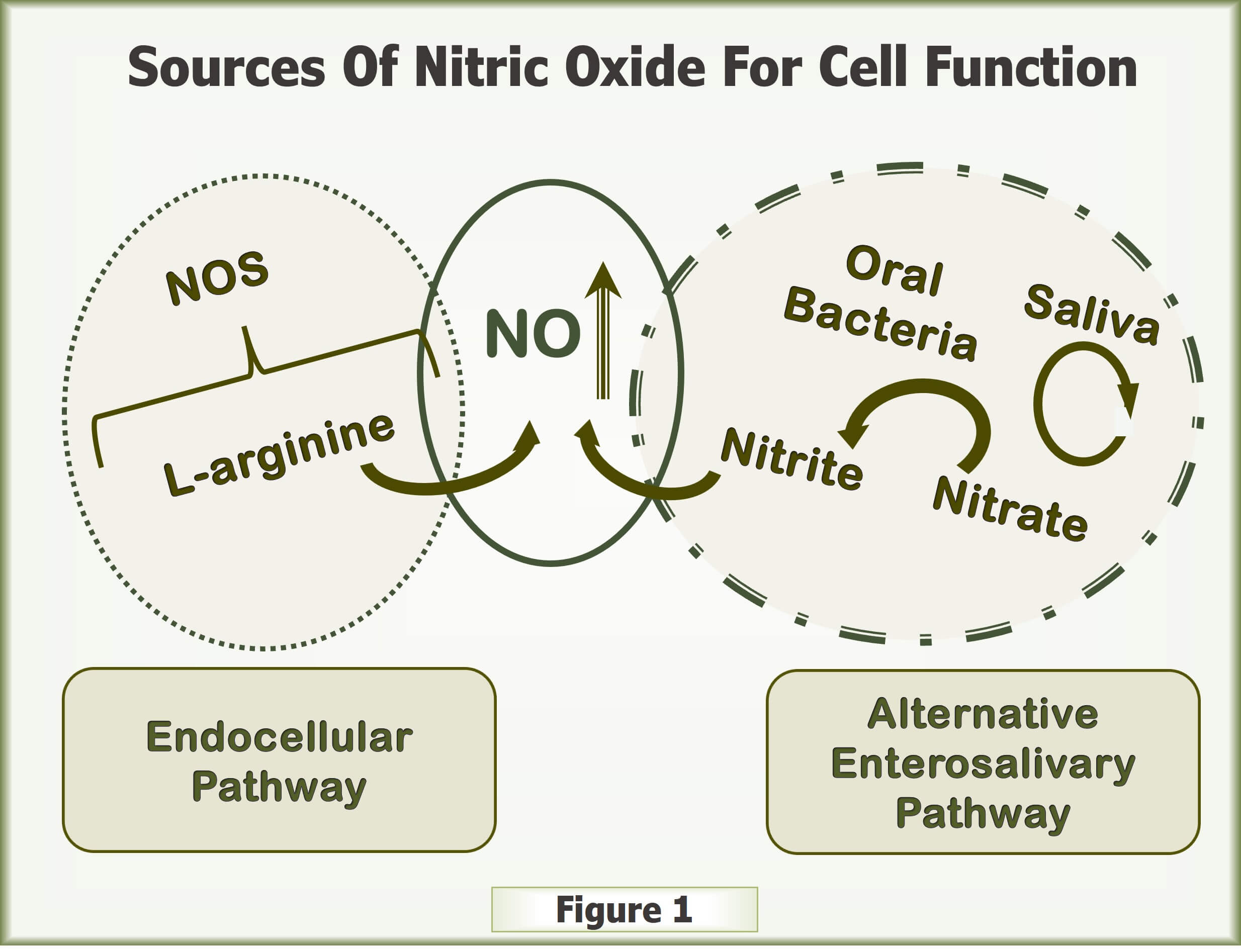
Figure 1 shows nitric oxide for cell function. Excess escapes into the systemic circulation.
Nitrates in saliva. Cells in salivary glands, like all cells, make nitric oxide. They also have a special ability to extract about 25% of the nitrates in blood plasma. Various amounts of extracted nitrate are reduced to nitrite. Some of the nitrite is swallowed into the stomach. However, some is further reduced to nitric oxide. The effect of nitric oxide in saliva is highly reactive against virus infections.
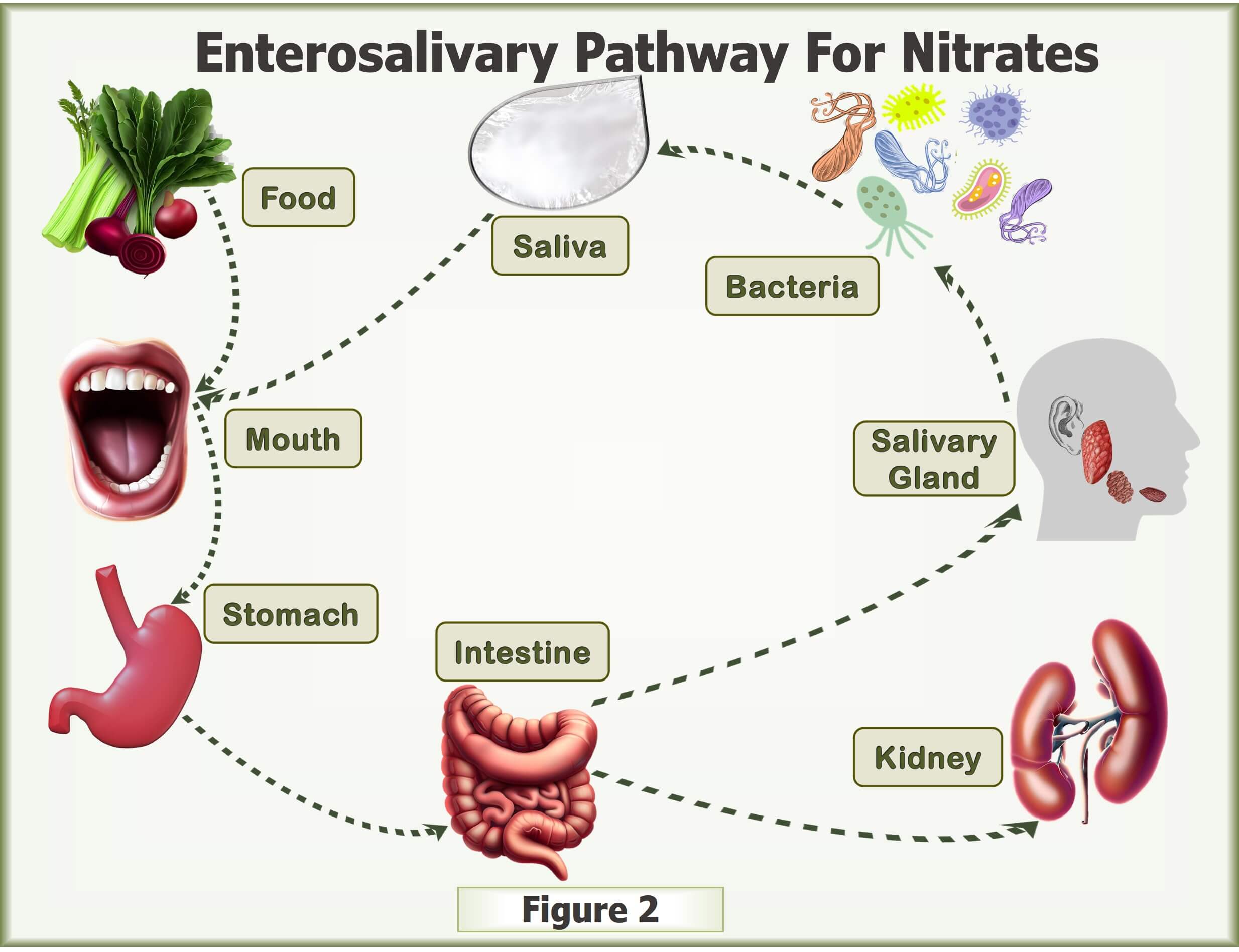 Figure 2 shows food containing nitrates coming into the mouth. After passing through to the stomach, nitrates are absorbed from the intestines. After passing into blood, nitrates circulate to all tissues and organs. Some nitrates dissolved in plasma circulate to the kidney for excretion in urine. 1
Figure 2 shows food containing nitrates coming into the mouth. After passing through to the stomach, nitrates are absorbed from the intestines. After passing into blood, nitrates circulate to all tissues and organs. Some nitrates dissolved in plasma circulate to the kidney for excretion in urine. 1
Nitrates extracted by the salivary glands are also exposed to bacteria in the mouth. These bacteria act in addition to oral enzymes in the salivary glands. They reduce nitrates to nitrites and finally to nitric oxide. Action of bacteria
is an even greater source of nitrite and nitric oxide than natural cells of the salivary glands.
Some of the nitrates, nitrites and nitric oxide are swallowed into the stomach. From there they enter into the general circulation. This recirculation keeps nitrates flowing through salivary glands for hours after first arriving in the systemic circulation.
 Figure 3 shows the effect of increasing content of nitrate in the diet for 2 weeks. Measures of nitrate and nitrite were made from serum of 46 healthy men. The peak value of nitrate appeared during the first week. During the second week, a gradual increase in bacterial action reduced levels of nitrate. During the same time, levels of nitrite increased. After 2 weeks, the nitrate supplement was discontinued. Values of nitrate and nitrite returned towards the initial levels. Note that adjustments in bacterial action kept nitrate and nitrite concentrations above their original levels.
Figure 3 shows the effect of increasing content of nitrate in the diet for 2 weeks. Measures of nitrate and nitrite were made from serum of 46 healthy men. The peak value of nitrate appeared during the first week. During the second week, a gradual increase in bacterial action reduced levels of nitrate. During the same time, levels of nitrite increased. After 2 weeks, the nitrate supplement was discontinued. Values of nitrate and nitrite returned towards the initial levels. Note that adjustments in bacterial action kept nitrate and nitrite concentrations above their original levels.
 Figure 4 shows the effects of the nitrate supplement on saliva pH. Bacterial conversion of nitrate to nitrite and nitric oxide gradually increased alkalinity of saliva. Some of the change in bacterial action was maintained even after nitrate supplements were discontinued. 2
Figure 4 shows the effects of the nitrate supplement on saliva pH. Bacterial conversion of nitrate to nitrite and nitric oxide gradually increased alkalinity of saliva. Some of the change in bacterial action was maintained even after nitrate supplements were discontinued. 2
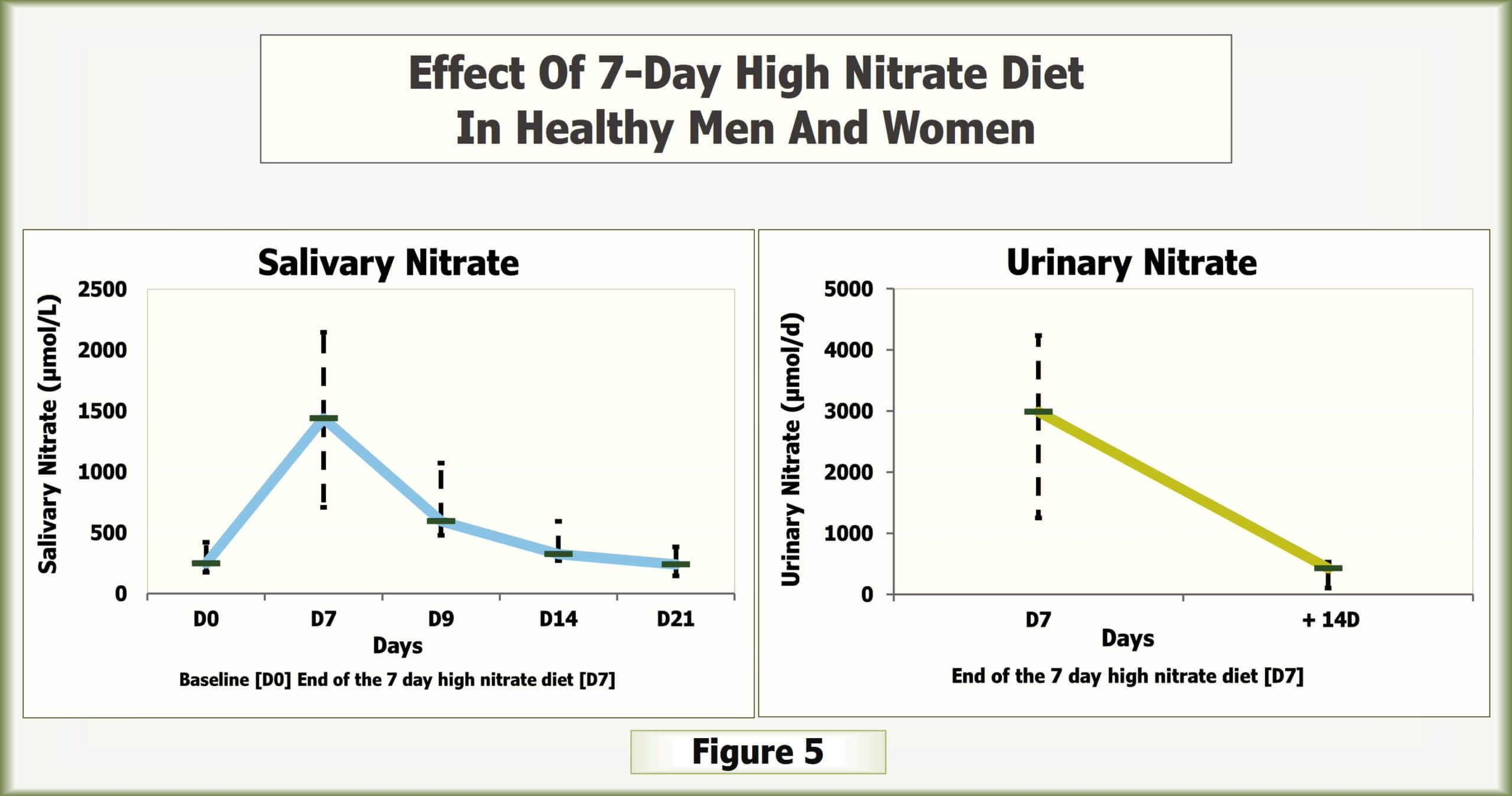 Figure 5 shows the effect of high nitrate diet in 19 healthy men and women
Figure 5 shows the effect of high nitrate diet in 19 healthy men and women
for 7 days. The average concentration of nitrate in saliva and urine increased more than 400%. After discontinuing the high nitrate diet, concentrations of nitrate in saliva and nitrate in urine were measured for 14 days. Values decreased back to original levels in 14 days. 3
Note that there was a wide distribution of individual values measured among all subjects. The wide distribution represents differences in bacterial conversion of nitrate metabolism. Each subject had different combinations of bacteria. Those differences caused a wide distribution of results. Reduction of nitrate to nitrite and nitric oxide was remarkably different for each individual.
 Figure 6 shows the effects of a single oral dose of supplemental nitrate. During 9 hours after ingestion, oral bacteria converted nitrate to nitrite. They also decreased salivary concentrations of lactic acid. In addition, they also increased concentrations of ammonium as well as forming nitrite. 4
Figure 6 shows the effects of a single oral dose of supplemental nitrate. During 9 hours after ingestion, oral bacteria converted nitrate to nitrite. They also decreased salivary concentrations of lactic acid. In addition, they also increased concentrations of ammonium as well as forming nitrite. 4
These actions decreased acid and increased concentration of alkaline molecules. The result was increased pH of saliva. These particular results indicate a general function. The higher the pH, the greater is the rate at which bacteria are reducing nitrite and forming nitric oxide.
Acute Respiratory Viral Infection
Upper respiratory tract infections (URTI’s) occur frequently. They are the most frequent cause of short-term illness and disability in the US. Most adults suffer at least 2 or 3 URTI’s every year. Each illness episode usually lasts at least 8 to 10 days.
Immunity protects against entry of virus particles into cells. However, acid saliva allows entry into cells and replication by SARS-CoV-2 virus. Also, acid saliva allows intracellular penetration and replication by Influenza viruses. Current vaccines against SARS-CoV-2 and Influenza viruses protect against replication and transmission about 50% of the time. Current vaccines against Respiratory Syncytial Virus infection are effective most of the time.
Rhinovirus (common cold) does penetrate cells even with alkaline saliva. Also, there are no effective vaccines available for protection against Rhinovirus disease. Fortunately, nitrate levels in blood and tissue fluid effectively enhance antiviral levels of nitric oxide. It is nitric oxide that is the most effective antiviral agent. It protects epithelial cells from Rhinovirus replication and spread.
Bacteria reduce nitrate to nitrite. They also convert nitrite to nitric oxide. The actions that form nitric oxide also protect against acid levels in saliva. As a result, alkaline saliva indicates strong antiviral protection by nitric oxide against Rhinovirus infection. It also prevents URTI viruses from replicating in cells of mouth, nose and throat.
Nitric Oxide Deficiency
Maintaining optimal nitric oxide levels is essential for good health. In particular, it provides protection from respiratory viral infection. Deficiency of nitric oxide occurs when cells don’t produce enough. The result is poor function of organs and tissues all over the body.
Deficiency is commonly caused by aging, chronic medical conditions, poor diet and lack of exercise.
Natural process of aging causes metabolic dysfunction. Cellular production of nitric oxide normally is highly effective. However, with aging, essential enzymes gradually become less efficient. Particularly in acidic conditions and low oxygen concentration. As a result, cellular function no longer maintains adequate production of nitric oxide. Plasma levels of nitrite and nitrate fall.
Protection from respiratory viral infection depends on a continuing supply of nitrate to salivary glands. A decrease in plasma nitrate causes a decrease in salivary nitrite and nitric oxide. The result is decreased alkalization of saliva.
Measuring local production of nitric oxide. Measurements of forearm blood flow show the amount of nitric oxide produced locally. Brief blocking of blood flow uses up all the oxygen in the forearm. When there’s no oxygen, the nitric oxide enzymes stop producing nitric oxide. When blood starts flowing in again, any nitrate and nitrite flowing out is what flowed in. The amount of reduction indicates the amount of nitric oxide produced locally.
Decrease in local nitric oxide production in average healthy adults begins by about 30 years of age. Decrease gradually gets worse with age.
 As shown in Figure 7, local production of nitric oxide is fully effective up to about 20 years of age. At about age 40, progressive decrease reduces local production by about 50%. By 60 years of age, local production is reduced by about 80%. 5
As shown in Figure 7, local production of nitric oxide is fully effective up to about 20 years of age. At about age 40, progressive decrease reduces local production by about 50%. By 60 years of age, local production is reduced by about 80%. 5
Poor diet and lack of exercise. Figure 7 also shows that good amounts of dietary nitrate and physical activity support circulating levels of nitrates and nitrites. Healthy levels help maintain adequate local production of nitric oxide. The combined result provides enough nitric oxide to help maintain local blood flow.
Effects of nitric oxide in the brain. Cognitive ability includes functions that we are aware of when we’re awake. These are sometimes called “executive functions.” They enable us to plan, focus attention, remember instructions, and juggle multiple tasks successfully. They include memory and skilled thinking. These actions are especially performed in the prefrontal cortex of the brain.
During aging, the overall volume of the brain begins to shrink. Starting to shrink at age 40 with the rate of shrinkage increasing around 60 years of age. Structural and functional changes occurring in the prefrontal cortex have damaging effects on conscious cognitive ability.
Healthful lifestyle counteracts age-related changes in the prefrontal cortex. This includes increased availability of nitric oxide by diet, oral supplements and physical activity. The results we want to maintain cognitive function to filter distractions, prioritize tasks, set and achieve goals, and control impulses.
Some chronic medical conditions increase risk of Respiratory Viral Infection. They are either partially caused by Nitric Oxide Deficiency or become NO deficient as the chronic condition progresses. Once infected, they may also be resistant to nitric oxide correction of viral replication. The result may be replication and transmission to adjacent host cells.
Commonly encountered chronic medical conditions that enhance risk of respiratory viral infection include:
• High Blood Pressure
• Overweight/Obesity
• Type 2 Diabetes Mellitus
• Chronic Kidney Disease
• Atherosclerotic Cardiovascular Disease
• Metabolic Syndrome
• Chronic Obstructive Lung Disease
Immune Response To Supplemental Nitrates
Improvements in nitric oxide function can occur quite quickly. Studies show that ingestion of nitrates increases levels of nitric oxide in air entering and leaving the lungs.
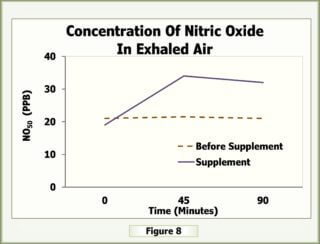 Figure 8 shows average concentrations of nitric oxide in exhaled air. Beetroot juice was used by 38 healthy men and women to increase intake of nitrates. After drinking the juice, measurements were taken for 90 minutes.
Figure 8 shows average concentrations of nitric oxide in exhaled air. Beetroot juice was used by 38 healthy men and women to increase intake of nitrates. After drinking the juice, measurements were taken for 90 minutes.
After 45 minutes, levels of nitric oxide in exhaled air were increased from 19 to 34 PPB. These data illustrate the potential for rapid response to dietary nitrate in preventing respiratory viral infections.
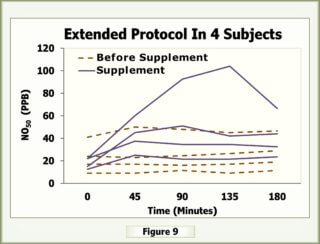 Figure 9 shows values from 4 of the healthy subjects. Note that levels of nitric oxide were increased for at least 3 hours. Also, note different individual levels of nitric oxide. These different levels were caused by different rates of bacterial reduction of nitrate to nitrite and nitric oxide. 6
Figure 9 shows values from 4 of the healthy subjects. Note that levels of nitric oxide were increased for at least 3 hours. Also, note different individual levels of nitric oxide. These different levels were caused by different rates of bacterial reduction of nitrate to nitrite and nitric oxide. 6
Summary
Prevention of respiratory viral infection starts with preventing penetration of respiratory and immunity cells. Most respiratory viruses require acid saliva and acid mucosal fluid for attachment and penetration.
Oral bacteria reduce nitrates to nitrite. At the same time, they produce ammonium and nitric oxide. They also reduce the effects of lactic acid. All of which prevents saliva from becoming acid. Nitric oxide also prevents replication and spread of any rhinovirus particles that do penetrate host respiratory cells.
Restoration and maintenance of cognitive function depends on nitrates circulating in blood flowing through the brain. Most of the nitrates are produced in skeletal muscle by physical activity. They also come from oral sources. These include dietary nitrates from food and nutrition supplements. Concentrated sources of nitrates are extracted from green and leafy vegetables. 7
Nitric oxide in the brain directs cognitive function, including memory and critical thinking. Nitric oxide also helps regulate cerebral blood flow supplying oxygen and nutrients for energy.
Effects of normal aging appear even in healthy adults. By age 40, organs and tissues start to decrease production of nitric oxide. By age 50, amounts are reduced by about 50%.
The decrease in production of nitric oxide can be avoided by physical activity. Regular exercise at moderate levels of intensity actually increases bioavailability of nitric oxide. Otherwise, what has been lost must be supplied from dietary nitrates or nutrition supplements.
What Would You Like To Do?
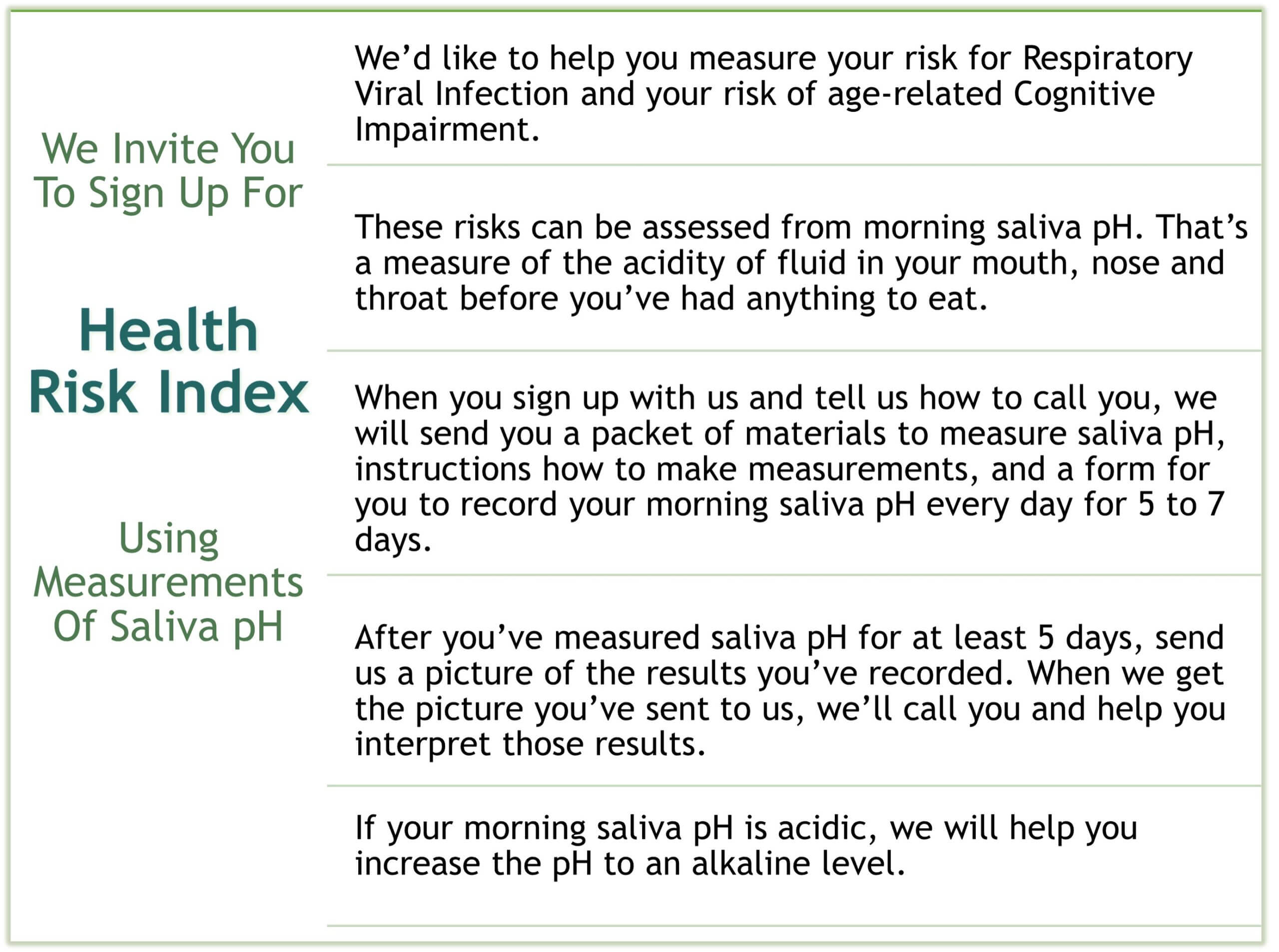



______________________________________________________________________________________________________
REFERENCES
- Ma L, Hu L, Feng X, Wang S. Nitrate and Nitrite in Health and Disease. Aging and disease. 2018,9(5): 938-945 https://doi.org/10.14336/AD.2017.1207
2. Hohensinn B, Haselgrübler R, Müller U, Stadlbauer V, Lanzerstorfer P, Lirk G, Höglinger O, Weghuber J. Sustaining elevated levels of nitrite in the oral cavity through consumption of nitrate-rich beetroot juice in young healthy adults reduces salivary pH. Nitric Oxide 2016;60,10-15. https://doi.org/10.1016/j.niox.2016.08.006
3. Bondonno CP, Liu AH, Croft KD, Ward NC, Puddey IB, Woodman RJ, Hodgson JM. Short-Term Effects of a High Nitrate Diet on Nitrate Metabolism in Healthy Individuals. Nutrients 2015;7,1906-1915. https://doi.org/10.3390/nu7031906
4. Rosier BT, Buetas E, Moya-Gonzalvez EM, et al. Nitrate as a potential prebiotic for the oral microbiome. Sci Rep 2020;10,12895. https://doi.org/10.1038/s41598-020-69931-x
5. Torregrossa AC, Aranke M, Bryan NS. Nitric oxide and geriatrics: Implications in diagnostics and treatment of the elderly. J Geriatr Cardiol. 2011;8(4):230-242. https://doi.org/10.3724/SP.J.1263.2011.00230 Full Article: https://www.ncbi.nlm.nih.gov/pmc/articles/PMC3390088/
6. Kroll JL, Werchan CA, Rosenfield D, Ritz T. Acute ingestion of beetroot juice increases exhaled nitric oxide in healthy individuals. PLoS ONE 2018;13(1): e0191030. https://doi.org/10.1371/journal.pone.0191030
7. Alharbi M, Stephan BC, Shannon OM, Siervo M. Does dietary nitrate boost the effects of caloric restriction on brain health? Potential physiological mechanisms and implications for future research. Nutrition & Metabolism. 2023;20(1):45. https://doi.org/10.1186/s12986-023-00766-9



